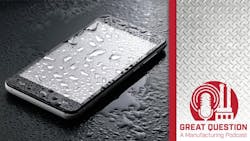Podcast: Understanding IP ratings for industrial networking devices
In harsh industrial environments, reliable network connectivity is paramount. However, dust, moisture, and extreme conditions can wreak havoc on sensitive electronic equipment, leading to costly downtime and operational disruptions. In this episode of Great Question: A Manufacturing Podcast, New Equipment Digest's Editor-in-Chief, Laura Davis, dives into the world of IP67-rated network devices and why understanding the IP rating system is essential for selecting the right industrial networking device.
This information was originally written by Henry Martel, a field applications engineer at Antaira Technologies, a company that manufactures industrial networking and communication solutions. Whether you're specifying network devices for a harsh environment, upgrading existing infrastructure, or simply looking to understand the critical role of ingress protection, this episode provides the knowledge you need to make informed decisions and ensure network reliability.
Below is an excerpt from the transcript:
Dust and water are the enemies of sensitive electronic components. Once inside a device enclosure, there's a possibility that over time it will corrode and deteriorate critical components, leading to overheating and eventual malfunction. Prevention relies on the enclosure's sealing effectiveness. So, how can we determine whether an enclosure suits the industrial environment in which it's deployed?
Enter the International Electrotechnical Commission (or the IEC). In 1975, the IEC created the IP rating system (which stands for Ingress Protection), to gauge a device enclosure's ability to keep out liquids and solids. Compared to ambiguous marketing terms like “waterproof” or “sealed,” the IP rating gives prospective buyers precise information regarding how well the enclosure will guard against the intrusion of external elements. Industrial and network security device manufacturers use IP ratings extensively. A certified IP rating legitimizes an industrial network device and allows manufacturers to claim the level of protection their product delivers confidently. Manufacturers do not conduct their IP certification. Rather, devices are tested by independent companies, such as Underwriters Laboratories (known as UL), by performing a series of trials that replicate real-world conditions.
